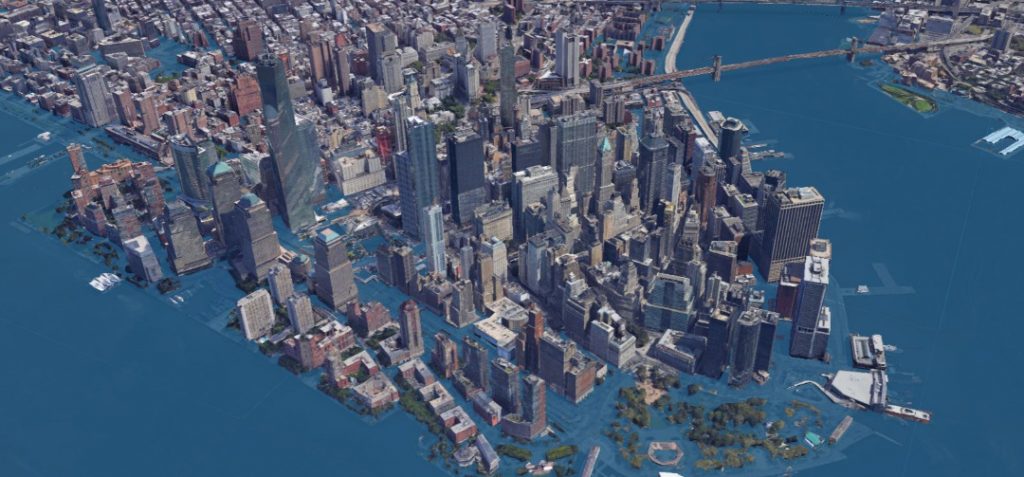
As you know, this newsletter is usually fairly inspiring. But this one is not (overall). And that’s because we really need to talk about sea level rise again.
Sorry, but the stakes are insanely high and everyone needs to know about this stuff!
That being said, I do end with an action you can take to help if you so choose! …Or you can just tell your friends about this mind-bending sea level rise predicament. Talking about these things and finding new ways to help together is always good.
Key Takeaways:
- We’ve locked in about 7.5 ft (2.3 m) of sea level rise already.
- Sea levels will likely be at least 3.3 ft (1 m) higher by 2100.
- Last time Earth got this hot, sea levels were way, WAY higher.
- Ice loss in Greenland and Antarctica is decades ahead of schedule. There’s been significant acceleration.
The fact of the matter is that coastal cities around the world will eventually have to make sci-fi adaptations or retreat…but I’m getting ahead of myself.
Setting the scene
Sea levels have gone up 7 to 8 inches since 1900.
Contributions came from:
- Expansion of the ocean as it gets warmer.
- Temperate land ice.
- Greenland and Antarctica.
But recently, Greenland and Antarctica (the two ice behemoths) have started to chip in more and more…faster and faster. They are the X factors of sea level rise. And scientists have severely underestimated how fragile they are.
Wrapping Your Head Around These Melting Giants
Imagine an ice cube that’s over 1 mile high. Now imagine that ice cube covering all of Mexico and the United States. That’s how big Antarctica is.
It holds enough ice to raise sea levels by 188 feet (57 meters).
Antarctica is now losing 252 billion tonnes of ice each year. It takes every country on Earth combined ten days to use that much water. (Antarctica actually loses over 2 trillion tonnes each year, but makes up for most of it with gains from snowfall)
That means it’s losing ice at a rate of 3 Olympic swimming pools every second (net). That’s 6 times faster than it was 40 years ago. This is largely due to warmer ocean water.
And then there’s Greenland.
Greenland is as big as Germany, France, Spain, and Italy combined. It holds 24 feet (7 m) of sea level rise at bay in its ice. Like Antarctica, Greenland is losing ice 6 times faster than it was in the 1980s (286 billion tonnes per year now).
Scientists have been caught off guard by the rapid acceleration of ice loss. They thought Antarctica, in particular, was much more stable than it is. As they learn more about feedback loops and get more high-quality observational data from satellites, they are significantly raising their sea level rise projections from even just a few years ago.
“At every point, as our knowledge increases, we’ve always discovered that the climate system is more sensitive than we thought it could be, not less.” – Dr. Maureen E. Raymo
Ultimately, these ice giants haven’t raised sea levels by much so far, but the key thing to know is that the rate of ice loss is accelerating – think exponentially, not linearly – compounding over time. We have not seen the last of glaciers as big as Manhattan calving into the water.
As James Hansen says, “The disintegration of ice sheets is likely to be highly non-linear.”
So, if you’re keeping track, that’s about 212 feet of sea level rise in ice that’s melting at faster and faster rates, in addition to melting glaciers, and an ocean that’s expanding simply because it’s getting hotter (oceans absorb 90% of the additional heat from global warming).
…Which means it’s not a question of if we’ll get a lot of sea level rise, but how much exactly? By when? And, in the long run, how much sea level rise is already locked-in?
To help answer these questions and add some context, let’s take a quick look at what sea levels have done in the past under similar conditions.
What Were Sea Levels Like Last Time Earth Got This Hot?
Ryan Hagen writes to help reverse global warming and bring more sustainability into the world. He is the founder of Crowdsourcing Sustainability and sends out an informative, uplifting, and actionable sustainability newsletter every two weeks.